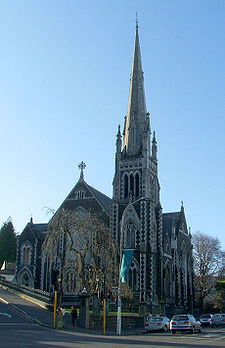
Knox Church, Dunedin
Encyclopedia

Dunedin
Dunedin is the second-largest city in the South Island of New Zealand, and the principal city of the Otago Region. It is considered to be one of the four main urban centres of New Zealand for historic, cultural, and geographic reasons. Dunedin was the largest city by territorial land area until...
, New Zealand
New Zealand
New Zealand is an island country in the south-western Pacific Ocean comprising two main landmasses and numerous smaller islands. The country is situated some east of Australia across the Tasman Sea, and roughly south of the Pacific island nations of New Caledonia, Fiji, and Tonga...
. It houses the city's second Presbyterian congregation and is the city's largest church of any denomination. Situated close to the university
University of Otago
The University of Otago in Dunedin is New Zealand's oldest university with over 22,000 students enrolled during 2010.The university has New Zealand's highest average research quality and in New Zealand is second only to the University of Auckland in the number of A rated academic researchers it...
at the northern end of the CBD
Central business district
A central business district is the commercial and often geographic heart of a city. In North America this part of a city is commonly referred to as "downtown" or "city center"...
on George Street
George Street, Dunedin
George Street is the main street of Dunedin, the second largest city in the South Island of New Zealand. It runs for two and a half kilometres north-northeast from The Octagon in the city centre to the foot of Pine Hill. It is straight and undulates gently as it skirts the edge of the hills to its...
it is visible from much of the central city.
It was designed by Robert Lawson
Robert Lawson (architect)
Robert Arthur Lawson was one of New Zealand's pre-eminent 19th century architects. It has been said he did more than any other designer to shape the face of the Victorian era architecture of the city of Dunedin...
in the 13th century Gothic
Gothic architecture
Gothic architecture is a style of architecture that flourished during the high and late medieval period. It evolved from Romanesque architecture and was succeeded by Renaissance architecture....
style and construction began in 1872. It is the second building for the congregation. The first, completed in 1860, was the second Presbyterian church in the settlement. It was a large wooden structure sited in Great King Street, close to the University of Otago Faculty of Dentistry
University of Otago Faculty of Dentistry
University of Otago Faculty of Dentistry is one of the faculties of the University of Otago.Founded in 1907, the Faculty of Dentistry is the only Faculty and School of Dentistry in New Zealand. It forms an integral part of the Division of Health Sciences within the University of Otago in Dunedin...
building. Though this was only ever intended to be a short-term home for the Knox congregation the onset of the Central Otago Gold Rush
Central Otago Gold Rush
The Central Otago Gold Rush was a gold rush that occurred during the 1860s in Central Otago, New Zealand...
intensified the need for a larger, permanent structure.
Church officials held a competition which was won by Lawson. His plans, however, would have exceeded the church's £5,000 budget and the deacons fell back on a design by David Ross. Because he insisted on employing an inspector of works who "could be bought at any time with a pot of beer", Ross's contract was annulled within two months. The church authorities approached Lawson again and he took over the project. (Ross successfully sued but was awarded a mere £2 in damages.).
The building eventually cost £17,757 and was opened on November 5, 1876. Constructed of bluestone
Bluestone
Bluestone is a cultural or commercial name for a number of dimension or building stone varieties, including:*a feldspathic sandstone in the U.S. and Canada;*limestone in the Shenandoah Valley in the U.S...
from quarries close to the Water of Leith
Water of Leith, New Zealand
The Water of Leith , is a small river in the South Island of New Zealand.It rises to the north of the city of Dunedin, flowing for 14 kilometres southeast through the northern part of the city and the campus of the University of Otago before reaching the Otago Harbour...
, and with Oamaru stone
Oamaru stone
Oamaru stone is a hard, compact limestone, quarried at Weston, near Oamaru in Otago, New Zealand.The stone is used for building purposes, especially where ornate moulding is required. The finished stonework has a creamy, sandy colour...
dressings and spire, its plan forms a Latin cross, with a nave 30 metres in length and 22 metres in average width. The spire rises to a height of 51 metres. Unusually for a New Zealand church, it contains two pipe organs, a large Hill, Norman, & Beard one installed in 1931 and extensively refurbished in 1974, and a smaller oak-case instrument originally installed in a church in Christchurch.
Because of maintenance requirements and the need to install a new fire sprinkler system the church was closed for the first time in June 2008. The congregation joined that of First Church for the duration of the three month project. The building was reopened after renovations were completed in September 2008. While the primary reason for closing the church was to install the sprinkler system there was also a need to restore some of the windows. Faces, feet and other details had faded over time and work was necessary to make these visible again.
Further reading
- Croot, C. (1999). Dunedin churches, past and present. Dunedin: Otago Settlers Association.
- Ross, A. (1976). They built in faith: A short history of Knox Church, 1860-1976. Dunedin: Crown Print.

